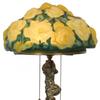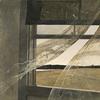Delacroix Work for the Palais du Luxembourg Heads to Auction
- PARIS, France
- /
- November 26, 2017
Paris auctioneer PIASA will offer a painting by Eugène Delacroix from a private collection at a Dec. 6 auction. This painting was made in 1840 for the decoration of the senator’s library in the Palais du Luxembourg. Sold in 1864 during the artist's atelier auction, the piece went from private collections to the present owner. The Delacroix Museum in Paris retains another similar conception model for the Palais Bourbon library’s hemicycle, the theme of “Orpheus comes policing the still savage Greeks”.
Eugène Delacroix was commissioned in 1840 for the decoration pf the senator’s library in the Palais du Luxembourg, which he would finish six years later. The set includes a dome, four pendants and a hemicycle situated over a window, made with marouflaged canvas. On the cupola, Delacroix painted a theme inspired by Dante’s Inferno, Canto IV, the limbo where are gathered the heroes of Antiquity, most of them writers, ‘having not received the grace of baptism’. All around, on the pendants, Delacroix realized the allegorical figures of Eloquence, Theology, Poetry, and Philosophy.
The subject of the hemicycle is thus described in the posthumous catalogue of the sale: “Alexander, after the battle of Arbelles, confines Homer’s works in a gold case”. Delacroix himself delved on the subject in a letter to Philippe Burty: “[Alexander] is represented sitting on an elevated seat, near a large trophy erected on the battlefield. To his feet are captives leading children, satraps in a pleading posture. Victory, its wings spread, crowns the winner. Behind the group of figures carrying the case, a shattered chariot and the battlefield in the distance.” This antique episode is reported by Latin historians, Quinte Curce in his History of Alexander the Great, and Plutarch in his Lives of Noble Greeks and Romans.
At the same period, Delacroix was deeply involved in the decoration of the députés’ library at the Palais Bourbon, where a medallion on the same theme is displayed, with a different composition. The vaulted semi-dome of the ceiling was prepared through many drawings in the Louvre museum.
A comparison between the offered piece and the definitive version reveals a few discrepancies. To Alexander’s right, Delacroix added, in the fresco, a soldier holding a spear, and another wearing a helmet along with a bearded prisoner on the far right. The palm trees and the female prisoner, at the right angle, are slightly modified. On the left hand side, a new figure is also introduced: a warrior holding several banners in his arms near the trophy pile. To the far left, the soldier’s equipment has been laid down on the chariot in the final version, and the horses head toppled. These changes in the work’s composition allowed to better adapt the subject to the semi circular shape of the apse.
In a letter from Frédéric Villot to Alfred Sensier, published in the Revue internationale de l'art et de la curiosité on the 15th of July, 1869, mentions the artist’s preparatory work: “The very day after our meeting, he began the work, that is, he piled sketch upon sketch, composition upon composition. Then, when the main scene was found, as well as the episodes, he began the painted sketch. […] He managed to find the trick to use in such case only after much trial and error and thanks to a small wood or cardboard model of a dome. Still, if my memory serves well and despite all his precautions, he had to rectify, on site, a few movements that were not satisfying from below.”











100x100_c.jpg)


